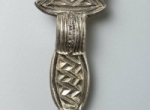Thuringi
Thuringii (alternative names in Latin – Thueringi, Thoringi). A Germanic tribe →Germanic Tribes established in central Germany between the Elbe River, the Harz mountain range and the Thuringian Forest, and also in parts of today’s Franconia.
Little is known about their origins. T. emerge as a separate tribe during the 3rd (4th century ?) AD, possibly evolving from the tribe of the Hermunduri, who are identified with Elbian archaeological cultures. In the past the name of the Thuringii used to be traced to that of the Hermunduri (Hermunthuringi) but this view is no longer tenable. It is accepted at present that groups of Angles, Warni, and possibly, other Germanic tribes as well, were involved in the ethnogenesis of T. as they assimilated into the local substratum.
During the first half of the 5th century T. found themselves under the influence of the Huns; this is evidenced by burials of women with artificially deformed skulls, some with Mongoloid traits. According to Late Antique written sources, around mid-5th century troops of Thuringii were serving in the armies of →Attila, king of the →Huns . The first king of the Thuringii confirmed in the written record, Bisinus, ruled on the turn of the 5th/6th centuries. The kingdom of the Thuringii became an important player on the Central European political scene, the most powerful Germanic state outside the borders of the former Roman Empire. According to Gregory of Tours, after Bisinus, Thuringia was ruled by three brothers, Baderic, Herminafrid and Berthachar.
As their kingdom grew increasingly powerful the Thuringii came into conflict with the Frankish Merovingians. After several battles only Herminafrid remained in power; through marriage with Amalaberga, niece of king Theodoric the Great, he allied himself with the family of this powerful ruler. After the death of Theodoric the attacks of Franks on T. intensified. The turning point came in 531 when the Thuringii were defeated in a battle at Burgscheidungen on the Unstrut River by Franks led by their king Theuderic (eldest son of Clovis I) and their territory was joined to that of the Frankish kingdom. Subsequent to these events, harassed by the Avar-Slavs, the Thuringii withdrew from the part of their found east of the Saale River which, for many centuries to come, would be a border with the →Slavs .
To control the situation in the part of his kingdom occupied by T. and to repel Slav invasions Dagobert I (son of Chlotar II), from 623 the king of Austrasia and from 629 king of all the Franks, established the Duchy of Thuringia in 630 and installed the Frankish aristocrat Radulf as its ruler. From that time Thuringia became an integral part of the Merovingian kingdom.
JS
Literature: B. Schmidt, Die späte Völkerwanderungszeit in Mitteldeutschland, Halle (Saale) 1961; B. Schmidt, Hermunduren – Angeln – Warnen – Thüringer – Franken – Sachsen, [in:] Studien zur Sachsenforschung 13, 1999, p. 341-366; M. Mączyńska, Świat z popiołu. Wędrówki ludów w Europie w IV i V wieku, Warszawa 2013.
-
 full resolution
full resolution
FIg. 1. A Thuringian brooch, type Zangenfibel, first half of the 6th c., Cranachstraße, Weimar (http://www.museum-digital.de/thue/index.php?t=objekt&oges=1567).


